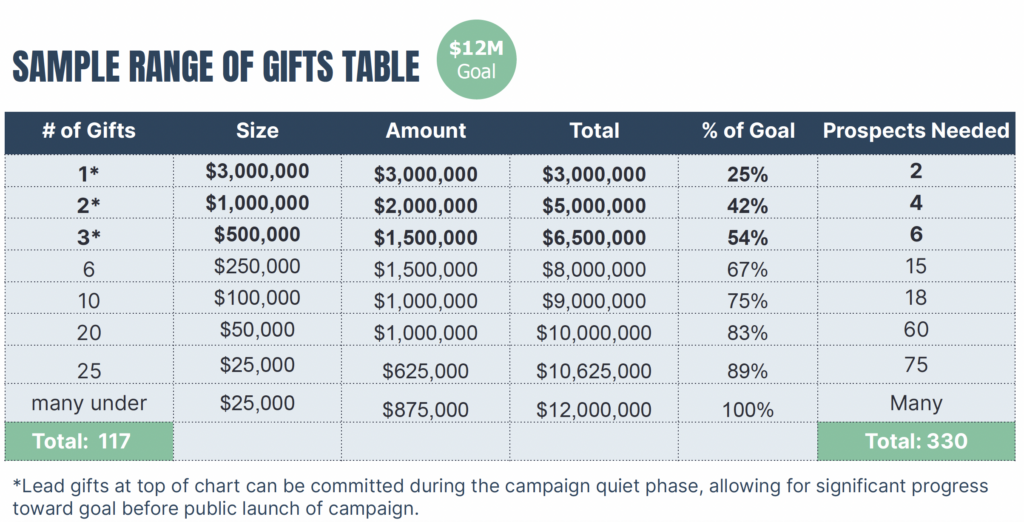At CFA, we believe successful campaigns are driven by big ideas. At their core, campaigns are encapsulated in relationships and numbers, artfully woven together, and informed by data and intuition.
While each phase of a campaign serves an important purpose – laying the groundwork, gathering critical information, and engaging donors – the campaign quiet phase is a distinct inflection point in a campaign during which the art and science behind transformational campaigns comes fully into view.
THE IMPORTANCE OF QUIET PHASES
Also known as the “silent phase” of a campaign, quiet phases are often when the most significant work takes place. Quiet phases are uniquely important for several reasons:
- Momentum – Quiet phases are a focused yet flexible point in a campaign centered on building buy-in and securing early commitments from lead donors to set the tone for the campaigns’ success by inspiring gifts at similar levels and encouraging other donors to follow suit.
- Refinement – Quiet phases allow organizations to fine-tune their strategies, goals, and case for support based on insights gathered from major donors and stakeholders, enhancing the effectiveness of the public campaign.
- Financial Foundation – Quiet phases ensure a solid financial base by securing a substantial portion of the fundraising goal before launching publicly, increasing confidence and credibility, and motivating additional participation.
Quiet phases are not exclusive to capital campaigns, and serve a critical purpose during endowment and comprehensive campaigns as well. The quiet phase sets the stage for a successful campaign by securing a number of lead gifts from a small set of close and active donors. These gifts comprise the top of a campaign’s giving pyramid and chart the course toward the most important number associated with any campaign: the fundraising goal.

CFA Campaign Manager Anne Spears brings over a decade of fundraising experience, offering strategic guidance to organizations throughout each stage of their campaigns and supporting progress toward their campaign goals. According to Anne, “The quiet phase serves as a litmus test for a campaign’s vision and case for support. It provides sure footing for a fundraising team and the campaign while building buy-in and deeply engaging donors closest to the organization.”
Identifying donors to include in the quiet phase relies on fundraising intuition validated by prospect research and the campaign’s feasibility study. Anne recommends starting with the first donors that come to mind before even looking at a donor list. Donors at the top of a campaign pyramid will require in-depth prospect research to inform the appropriate ask amount, which is not often realistic for the majority of a campaign’s prospects.
Cultivating transformational gifts from lead donors requires significant time. The quiet phase allows fundraisers to focus on these close and critical donors while offering a period of flexibility in the campaign’s early development. The nature and tone of conversations with donors during this stage are inherently different, allowing more time and space to test ideas and ask for advice before goals, vision, and timeline are fully established and publicly announced. “Without a quiet phase dedicated to individually engaging these major donors early on, they are much less inclined to give at their full capacity,” shares Anne.
“Giving Inspires Giving”
The quiet phase also enables fundraisers to gain experience in the art of asking for large investments. “These will be your friendliest donors with the strongest affinity for your organization,” Anne states. Cultivation conversations with these close donors becomes an exercise in articulating the campaign’s vision and goals while asking insightful questions. Soliciting transformational gifts also comes down to knowing when the time is right to make “the ask.”
Significant contributions secured in the quiet phase can have a multiplying effect as a campaign gets underway. “Giving inspires giving,” comments Anne. “Donors are more likely to give meaningful gifts when others are giving at similar levels, and early gifts help to set the bar for future gifts.”
Hybrid Quiet Phases
The form and function of the campaign quiet phase is inherently exclusive because it focuses on a small set of high-capacity donors; a factor that is often necessitated by the limitations of a fundraising team’s capacity to equally and deeply engage donors at all giving levels. As a result, organizations seeking to align their campaigns with organizational values of equity and inclusivity can find the quiet phase to be problematic.
While some organizations may consider skipping the quiet phase in favor of a fully public campaign, CFA often advises organizations to take a hybrid approach by conducting a more inclusive feasibility process and identifying a few lead gifts following the feasibility study that can build confidence and catalyze additional giving as the public phase gets underway.
Regardless of the phase in which these early conversations and campaign commitments take place, they become an important source of validation by increasing donor confidence, motivating additional support, and building a solid foundation for a successful campaign.
CONTACT US
Campaigns are an extensive undertaking that require a balance of organizational strategy, experience, and stamina. At CFA, we have partnered with more than 50 organizations throughout the planning, execution, and sustaining of transformative campaigns. If your organization is interested in support to launch a successful campaign, contact CFA today to explore how we can help.
Anne Spears, Campaign Manager
An experienced fundraiser with over a decade of experience in education, religious, and social service based nonprofit fundraising, Anne is passionate about the work being done by nonprofit organizations. She is energized and inspired by working side by side with our nonprofit partners as a project manager for fundraising campaigns.
Most recently Anne was the Director of Development at the Episcopal Diocese of West Texas where she oversaw a multitude of initiatives including capital campaigns for Diocesan camp facilities from the South Texas Coast to the Colorado Rockies, campaigns to assist asylum seekers traveling from Mexico to the U.S., and consulted with the 87 Diocesan churches regarding their fundraising needs.
Previously Anne was the Chief Development Officer for Ascension DePaul Services of San Antonio and the Development Coordinator at St. Thomas Early Learning Center in College Station, Texas. She also worked for the State of Montana as a social services specialist serving indigenous and rural populations.
Anne has a B.S. in Sociology, a M.S. in Family and Child Studies, along with a Master of Public Administration. She also is a Certified Fundraising Executive (CFRE). Anne lives in San Antonio, Texas, with her husband and three children.
Kendall Carlson, Content Writer
A frequent contributor to CFA’s digital content, Kendall Carlson has spent her career advancing nonprofit organizations across the Twin Cities. With 16 years of experience, Kendall brings a balance of strategic and operational leadership spanning fundraising, program development, evaluation, and strategic planning. Most recently, Kendall served as Development and Communications Director at Hired, where she diversified revenue for the organization’s $11M budget and increased individual giving by 60%, led a rebrand, and launched an organization-wide data for impact initiative. Prior to Hired, Kendall served at Greater Twin Cities United Way, where she led an advancement strategy team to increase investment and engagement from the organization’s top corporate and major donors. Kendall is known as a strategic, solution-oriented leader with a high capacity for detail and commitment to quality. She launched her consulting practice, Luminate Consulting, in 2022 to bring her skills in fundraising and program strategy to nonprofits seeking sustainable growth.


